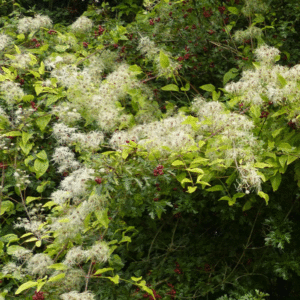Old Mans Beard
Old Man’s Beard
Clematis vitalba

This deciduous plant is nature’s clematis. Its nickname is Traveller’s Joy, which is understandable as it is one of the few plants to be seen in the bleak Winter landscape. The denuded hedgerows and bare banks are festooned in its silvery froth. This snowlike mantle is made up of a mass of seed heads which are a vital source of food for all Finches
Originally found in the South of England and usually on chalky soils, Old Man’s Beard has now spread over many areas of the UK but not in northern Scotland
Flowering in July to September with an abundance of small white flowers, it is much visited by pollinating inscets such as bees and hover flies and certain species of moths, including the Small Waved Umber and Small Emerald
It has been considered an invasive weed as it can form a densely thick blanket over trees and shrubs, however I treasure it for decorating the house in the Winter months when there is a scarcity of other flowers
It is thought to contain inflammatory properties and was used in the past to treat various ailments such as skin irritaions and stress. As Old Man’s Beard is a woody plant, its stems were used in basketweaving
Candida Hopkinson